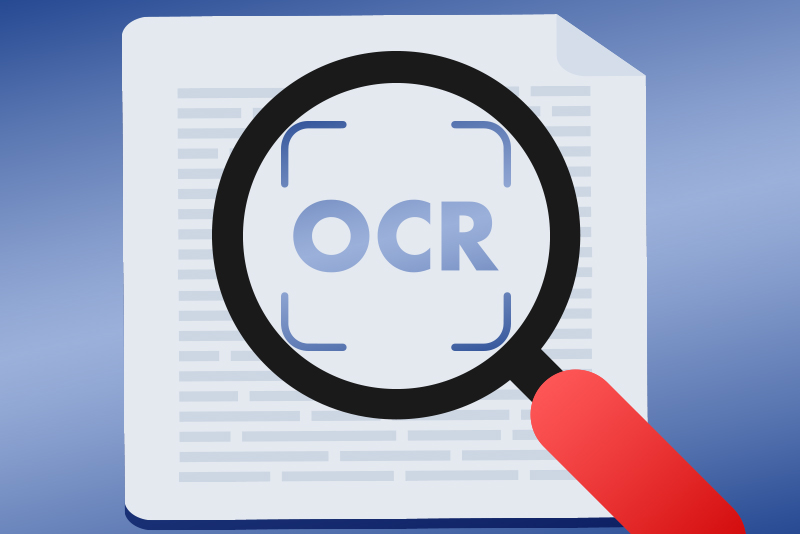The banking and financial services industry (BFSI) is considered one of the most highly regulated and monitored sectors in the world. The fact that the industry deals with a lot of financial instruments means that security, accuracy, and efficiency are at the forefront in terms of basic requirements for any tool to qualify for this industry. Banking is one of the several industries that uses OCR automation technology the most today. Optical character recognition technology (OCR) is a game-changing automation technology that is being highly used in banks. In simple terms, Optical Character Recognition (OCR) extracts data from scanned or image-based text files such as PDFs and converts it into machine-readable text that can be edited, formatted and searched. The use of this technology in banks helps revolutionize banking operations by making them easier, effortless, efficient and more effective. With OCR, banks can now process, monitor, and evaluate data, including large amounts of customer data such as personal and security information.
In recent years, OCR has become an important part of organizational processes or functions. According to reports, the global OCR market will reach $70 million by the end of 2030. OCR (Optical Character Recognition) is a technology that uses computer processing software to distinguish printed or handwritten text characters in digital images from physical documents (like a scanned paper document). The basic process of OCR is to examine the text of a document and translate the characters into code that can be used for data processing. It uses natural language processing technology (NLP), which helps identify letters and characters, and then copies them in the written format and order. Banking institutions are now taking advantage of OCR technology and providing their customers with a superior experience. In addition, banks are also using this technology for verification and fraud prevention.
Key Benefits of OCR for the Banking Industry
Generally, the banking sector is prone to financial crimes such as money laundering and account takeover fraud. OCR technology can help the banking industry identify fraudsters as the software checks for unauthorized documents. This technology helps make online banking an easy and user-friendly experience for users as well. Here are the key benefits of OCR in the banking industry:
- Simplify the Verification Process – AI-based OCR simplifies the verification process, especially in banking. Employees do not have to devote extra time to extract data from each document and verify its legality. Data extraction is done by the software and employees monitor all technological inconsistencies. Manual processes can take days to verify a single customer, while OCR can do the job within seconds.
- Reduce Verification Costs – Earlier, companies would hire a team to test each customer’s intake. In addition, the equipment required for verification is massive. By implementing artificial intelligence OCR, banks can save on equipment rental and purchase expenses significantly.
- Easy Fraud Prevention – Preventing fraudulent transactions has become a challenge for all banks. Money laundering, account takeover fraud, open banking, virtual currencies, and tax evasion are some of the fraudulent activities that the banking industry typically faces. OCR can now be used by banks to identify legitimate customers, and complete verification means less fraudulent activities.
- Legitimate Client On boarding – Nowadays, document forgery is very common and human verification cannot identify fake documents. More than simple document analysis, banks need something more rigorous. This is where OCR technology comes into picture as it can detect forged documents within seconds, making it easier for banks to filter fraudsters before they cause problems. Furthermore, onboarding legitimate customers is no longer an issue, and the customer experience is not at all compromised.
- OCR Optimization Time – When it comes to manual data acquisition and processing, validation may take at least a week. Employees must first satisfy customer requests. Then the document must be scanned and the relevant data extracted. After data extraction, it is converted into machine-readable language. However, AI-based optical character recognition takes the data, converts it into a machine-friendly form, and completes the process within seconds. This in turn allows employees to optimize the inspection time.
How OCR Has Transformed the Banking and Finance Industry
OCR has become an integral part of the banking and financial system. The technology is used for several purposes:
- Document Retrieval Systems – OCR technology can easily convert scanned or photographed (image-based) documents into a machine-readable format. This is essential for document archives where thousands of records are stored in a way that makes them searchable using keywords or keyphrases. Financial records are now just a few clicks away, making the entire system more efficient, while helping to maintain and comply with the intense security levels demanded by regulatory authorities.
- Modifying Scanned Files – OCR is the initial step in editing financial documents. Once the documents get converted into a specific format that can be read by software applications, it is easier to modify the underlying data. There are several PDF editors that can not only be used to edit PDFs but also to annotate them and organize a document’s pages (add, remove, replace, rotate, reorder, and extract.).
Why OCR Technology Needs the Integration of AI in the Banking Industry
Optical character recognition technology has brought a multitude of benefits for the banking industry. The most notable benefits are in document digitization. Banks need to synthesize and accumulate customer information for them selves to take advantage of this big data source for many bank projects in the future. With the combination of Artificial Intelligence (AI) and natural language processing technology (NLP), OCR has been expanded into data collection and management technology, playing a crucial role in the bank’s business process automation system. With integrated AI, OCR recognizes what it extracts and automatically improves output by machine learning. Learning from existing data and continuously adding missing knowledge can help test errors and handle physical documents quickly thereby saving time and cost.
For typed documents, OCR gives accuracy above 98 percent. In fact, accuracy is an important factor in banking as even small errors can lead to loss of important data. Banks use OCR as a means of transaction security and risk management. When using traditional OCR, users can only check documents manually. When integrated with AI and natural language processing technology (NLP), OCR improves the ability to automatically assess risks for any paper document. AI has the ability to analyze and process document content thoroughly, and detect abnormalities from credit payment information in customer data extracted.
Apart from the most common documents, banks often have to deal with several other documents such as identity cards (to get customer information), contracts, receipts, bank notes and financial statements that need to be digitized. The bank uses OCR software to scan customers’ handwritten guarantee documents (such as loan paper, power of attorney) that help recognize differences in new text arrangements. If there is any correction, a warning is sent to the supervisor about the change in the document format.
Many banks worldwide utilize OCR to incorporate facial recognition software to provide 2-layer security at the ATMs. Several mobile applications have been launched based on OCR technology that bring convenience to the users such as scanning checks and sending money with mobile phones. Customers only need to capture the account number, the amount and the signature at high resolution by phone, then OCR will be applied in the mobile application and the data will be sent to the bank for fast and quick processing.
Undoubtedly, Optical character recognition technology (OCR) has transformed very diverse business sectors, including banks and other financial institutions that struggle with paper workflows and massive archival rooms to store physical documents. In the banking world, OCR has revolutionized document-based processes by making workers more productive and systems more efficient overall. With OCR and AI technologies, banks can now streamline their workflows and process documents much faster than before. Other added benefits include document security, user authentication, faster communication, and overall a much more efficient banking system. Banking institutions can partner with a reliable document scanning company to achieve successful digital transformation and improved efficiency.
Having Data Management Issues?
Call us at (800) 670-2809 and Get your Free Trial Today!




